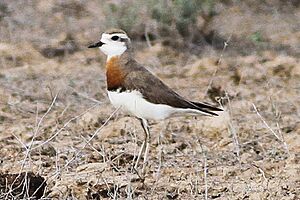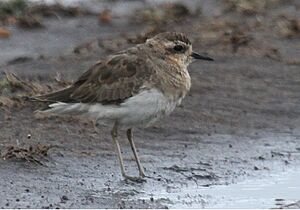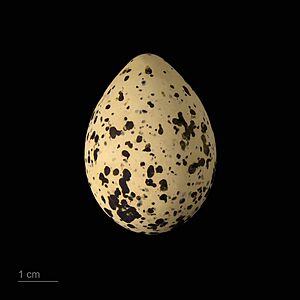Caspian plover facts for kids
Quick facts for kids Caspian plover |
|
|---|---|
 |
|
| Conservation status | |
| Scientific classification | |
| Synonyms | |
|
Charadrius asiaticus (protonym) |
The Caspian plover (scientific name: Anarhynchus asiaticus) is a type of wader bird. Waders are birds that often live near water and have long legs. This bird belongs to the plover family. The name asiaticus comes from Latin and means "Asian."
These plovers make their nests and raise their young in western and central Asia. When winter arrives in the north, they fly south to eastern and southern Africa to find warmer weather.
Contents
What Does a Caspian Plover Look Like?
The Caspian plover is a bit bigger than a ringed plover. It looks a little like the greater sandplover and lesser sandplover. However, the Caspian plover is thinner and has longer legs than the sandplovers.
It also has a very clear white stripe above its eye, called a supercilium. Its bill is long and thin. Unlike some other plovers, it does not have white feathers on the sides of its tail. It also has only a faint white stripe on its wing.
In summer, male Caspian plovers have grey-brown backs. Their faces and bellies are white. Their chest is a reddish-brown color, with a black border underneath. Other plovers, including female Caspian plovers in summer, have a grey-brown band across their chest. Sometimes, the summer female might show a hint of reddish-brown. When they call, they make a sharp chip sound.
Where Do Caspian Plovers Live?
The Caspian plover breeds in western Asia, around the Caspian Sea. Their breeding areas include southern Russia, Turkey, Iran, Turkmenistan, Kazakhstan, Uzbekistan, and Afghanistan. They like to live in wide, open grasslands called steppes. They also live on the edges of deserts, in areas with salty ground, and where there are only a few small bushes. They can be found up to about 800 meters (about 2,600 feet) above sea level.
After they finish breeding, these birds fly to eastern and southern Africa. They travel as far south as the Zambezi River. In winter, they usually live in dry grasslands, sand dunes near the coast, salty marshes, or dry areas that sometimes flood. Sometimes, they even live in farm fields.
The Caspian plover is very rarely seen in western Europe. It is also a rare visitor to Australia.
Life and Habits
Caspian plovers build their nests in open grasslands in central Asia. Most of these areas are north and east of the Caspian Sea. They often nest in small groups, but not too close together.
A female plover usually lays three eggs in a simple nest. The nest is just a small dip on the bare ground or among short plants.
These birds find their food in a similar way to other plovers. They pick up small insects like beetles, termites, ants, and grasshoppers. They also eat small snails and other tiny creatures, mostly from the ground. Sometimes, they even eat the seeds of grasses.
How Are Caspian Plovers Doing?
The Caspian plover lives across a very large area. The total number of these birds might be slowly going down. This is mainly because their breeding areas are changing, especially in Europe.
However, the IUCN (International Union for Conservation of Nature) says the Caspian plover is of "Least Concern." This means they are not currently in danger of disappearing. The IUCN does not think their numbers are dropping fast enough to put them in a more threatened group.
The Caspian plover is also one of the birds protected by an agreement called the Agreement on the Conservation of African-Eurasian Migratory Waterbirds (AEWA). This agreement helps protect birds that fly long distances between Africa and Eurasia.




